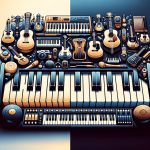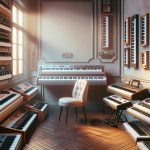Diving into the world of music with a synth keyboard can be both exhilarating and a bit daunting for beginners. It's like stepping into a new universe where the possibilities of creating sound are endless. But with the right beginner synth keyboard, learning the ropes can be more of an exciting adventure than a steep challenge.
Choosing the perfect starter synth doesn't have to be a puzzle. It's all about finding that sweet spot between user-friendly features and the ability to grow with you as your skills flourish. Whether you're dreaming of producing electronic masterpieces or simply looking to add a new dimension to your musical repertoire, the journey starts with that first keystroke.
Understanding Synth Keyboards
Entering the realm of synth keyboards opens up a fascinating world of musical exploration and creativity. For beginners, understanding the basic components and functionalities of these instruments is crucial for a fulfilling learning experience.
Synth keyboards, at their core, are electronic instruments designed to generate sound. They do this through various methods such as analog synthesis, digital synthesis, and sometimes a hybrid of both. The beauty of synthesis lies in its ability to produce a vast range of sounds—from emulating traditional instruments like pianos and strings to creating entirely new, never-before-heard auditory experiences.
One key aspect beginners should grasp is the difference between analog and digital synths:
- Analog Synths generate sounds through analog circuitry and often have a warmer, more 'organic' tone.
- Digital Synths use digital signal processing (DSP) to create sounds and offer greater versatility and stability.
For those starting, digital synths might be more appealing due to their preset sounds and built-in learning features like step sequencers and tutorials. These tools can greatly assist in understanding music theory and composition.
Another critical factor for beginners is the keyboard’s layout and the number of keys. Most beginner synth keyboards come in sizes ranging from 25 keys (2 octaves) to 61 keys (5 octaves). While smaller keyboards are more portable and cost-effective, larger keyboards provide a fuller range, allowing for more complex compositions. Here’s a quick reference:
| Number of Keys | Octaves | Best For |
|---|---|---|
| 25 | 2 | Portability and simplicity |
| 37 | 3 | Balance of range and size |
| 49 | 4 | Intermediate compositions |
| 61 | 5 | Full range and complexity |
Touch sensitivity is another feature that can greatly impact the playing experience. Keyboards with this capability can respond to the force of your touch, producing louder sounds when played hard and softer sounds when played gently, similar to an acoustic piano. This dynamic control is essential for expressing emotions through music.
Connectivity options are also vital for modern musicians. Many beginner synth keyboards come equipped with USB MIDI connections, allowing them to easily interface with computers and other digital devices. This connectivity enables beginners to explore music production software, expanding their creative possibilities.
Key Features to Look For

When embarking on the journey to find the perfect beginner synth keyboard, there are several key features that one should keep an eye out for. These features not only make learning more manageable but also ensure that the instrument can grow with the user as they advance in skill.
Polyphony is one of the first aspects to consider. Polyphony refers to the number of notes a synth can play at once. Beginners might not need a high polyphony count right off the bat, but having a keyboard that offers a decent range ensures that as one's skills develop, they won't be immediately limited by their instrument.
| Feature | Ideal Range |
|---|---|
| Polyphony | 8 to 32 notes |
| Keys | 61-88 keys |
| Connectivity | USB, MIDI, Audio Out |
Another critical factor is the number of keys. Most full-size keyboards come with 88 keys, mimicking a traditional piano layout. However, beginners might find smaller options, such as 61 or 76 keys, more manageable and less intimidating. These sizes still offer plenty of range for learning and practice, plus they're more portable.
The type of keys also plays a pivotal role. Weighted or semi-weighted keys can provide a more realistic piano feel, which can be beneficial for beginners who later wish to transition to playing an acoustic piano. On the other hand, synth-action keys might be lighter and easier for creating dynamic electronic music.
Connectivity options shouldn't be overlooked, either. A synth with USB, MIDI, and audio out connections offers flexibility for recording, live performances, and integrating other gear into one's setup. It's also handy for accessing digital learning resources and software that can enrich the learning experience.
Beginners should also look for synths that offer a range of built-in sounds and effects. These features allow for experimentation and can help keep practice sessions engaging and fun. The ability to layer sounds and use effects can greatly enhance the creativity of the music-making process, making it more enjoyable and rewarding.
Lastly, don't forget the importance of learning and practice features. Many beginner synth keyboards come with built-in lessons, metronomes, and songs. These tools can be incredibly valuable for self-learners, providing structured guidance and helping to develop timing and rhythm skills.
- Built-in Lessons: Assist in learning fundamentals.
- **Metronome
Best Beginner Synth Keyboards on the Market

When venturing into the world of synthesizers, the array of options can be overwhelming. However, there are a few standout beginner synth keyboards that strike the perfect balance between functionality, ease of use, and affordability. These selections not only cater to budding musicians' needs but also offer room for growth and exploration.
Yamaha Reface CS is a popular choice among beginners due to its intuitive layout and rich sound palette. With its 8-note polyphony, this compact synth allows for layered sounds and complex chords. The Reface CS shines in its simplicity, making it an ideal learning tool while providing enough depth for creative exploration. It boasts a range of onboard sounds and effects, eliminating the need for immediate additional equipment.
The Roland JD-Xi combines analog and digital synthesis in one machine, offering a powerful, versatile tool for learners. With a 37-mini key layout, it's easily portable yet packed with features. The JD-Xi includes a built-in drum machine and vocal FX, allowing beginners to experiment with composing full tracks. Its 128-note polyphony ensures that learners won't quickly outgrow the synth.
For those leaning towards software integration, the Novation MiniNova is an excellent fit. It's not just its 37 synth-action keys that make it great for learners, but its extensive connectivity options including USB, MIDI in/out, and audio out make it ideal for those looking to dive into recording and production. The MiniNova comes with a massive range of sounds, and its Vocoder functionality adds an exciting layer to vocal processing.
Here are a few standout features of these beginner synth keyboards:
| Feature | Yamaha Reface CS | Roland JD-Xi | Novation MiniNova |
|---|---|---|---|
| Polyphony | 8 Notes | 128 Notes | Depends on Patches |
| Number of Keys | 37 Mini | 37 Mini | 37 Synth-Action |
| Connectivity | MIDI, USB | MIDI, USB | MIDI, USB, Audio Out |
| Built-in Sounds | Yes | Yes | Yes |
| Portability | High | Medium | High |
Tips for Learning and Improving Your Skills

For those embarking on the journey of learning the synth keyboard, some fundamental practices can significantly enhance the learning curve. Understanding that each musician's journey is unique, these tips aim to provide a holistic approach underpinning skill development and creativity.
Start with the Basics
It's easy to jump ahead to complex compositions and soundscapes, but mastering the foundations is key. Begin with simple melodies and chords. They don't just help in building muscle memory but also in understanding the relationship between different sounds and how they come together to create music. Grasping the basics strengthens your ability to explore and innovate as your skills advance.
Practice Regularly
Consistency is the cornerstone of mastery. Setting aside time each day for practice doesn’t only solidify what you’ve learned but also encourages continuous improvement. Even short, focused sessions are more beneficial than sporadic, lengthy ones. They’ve made practice less overwhelming and more a part of daily routine, gradually building both confidence and capability.
Explore Different Genres
The versatility of synth keyboards allows for exploration across various musical genres, each with its unique sound palette and playing techniques. Diving into genres outside of your comfort zone can unlock new creative potentials and broaden your understanding of musicality. It’s not just about playing different sounds, but about experiencing and integrating diverse emotional expressions and rhythmic patterns into your playing.
Utilize Online Resources and Tutorials
We live in an age where a vast array of learning materials is readily accessible. Online tutorials, forums, and courses offer insights from seasoned musicians and connect you with a community of learners. These resources can provide novel techniques, inspiration for sound design, and practical advice for troubleshooting common challenges. They’re invaluable for self-taught musicians and those seeking to supplement formal lessons.
Experiment with Sound Design
Synthesizers are not just instruments but also powerful tools for sound creation. Experimenting with different settings, waveforms, and effects can lead to the discovery of unique sounds and textures. It's a process that encourages creativity and a deeper understanding of the synth’s capabilities. Engaging in sound design not only makes your music more personal but also enhances your technical proficiency with the instrument.
Exploring Advanced Features

Once beginners have mastered the essentials of playing synth keyboards, delving into the advanced features these instruments offer can significantly enhance their playing and sound design capabilities. Many beginner synth keyboards come equipped with a range of functions beyond the basic keys and sounds, which, when explored, can open up a whole new realm of musical creativity.
Advanced Sound Manipulation
One of the most exciting aspects of synthesizers is the ability to tweak and manipulate sounds to create something truly unique. Beginner models like the Yamaha Reface CS and Novation MiniNova provide users with options to alter waveforms, apply filters, and adjust envelopes. Learning how these parameters affect the sound can give budding musicians a deeper understanding of synthesis.
- Waveforms control the basic character of the sound
- Filters can remove certain frequencies to shape the sound
- Envelopes influence how the sound behaves over time
Spending time experimenting with these features, even on a smaller, more affordable keyboard, can significantly improve one's ability to craft personalized sounds.
Sequencers and Arpeggiators
Sequencers and arpeggiators are tools that automate note patterns and rhythms, adding complexity to compositions with minimal effort. For example, the Roland JD-Xi comes with a built-in sequencer that can record and playback note sequences, making it a powerful feature for both learning and composition. Arpeggiators, on the other hand, take chords and automatically play the individual notes in a sequence, offering a quick way to create dynamic and engaging soundscapes.
Understanding how to use these tools effectively can add depth to one's music, fostering both compositional and performance skills.
Connectivity and Integration
In today's digital age, the ability to connect a synth keyboard to external devices and software can greatly expand its functionality. Most beginner synth keyboards offer some form of connectivity, whether it's through traditional MIDI ports or USB connections. This allows for integration with digital audio workstations (DAW), enabling recording, sound editing, and even access to virtual instruments.
Exploring software integration can also introduce beginners to the world of music production, further broadening their musical capabilities. It's fascinating to discover how a simple keyboard can transform into an entire studio setup with the right tools and understanding.
Conclusion
Choosing the right beginner synth keyboard is a journey that opens up a world of musical possibilities. With options like the Yamaha Reface CS, Roland JD-Xi, and Novation MiniNova, there's a perfect fit for every aspiring musician's needs and preferences. The journey doesn't stop at the purchase, though. It's about diving into the basics, committing to regular practice, and constantly pushing the boundaries of creativity and technical skill. By exploring various genres, delving into sound design, and leveraging technology, learners can transform their musical ideas into reality. The path from beginner to proficient synth player is filled with discovery, growth, and the joy of creating music that resonates. So, grab a synth and start this exciting musical adventure today!
Harlan Kilstein began playing piano during covid with no piano background at all. He taught himself how to play learning what to do and what not to do.
Today he's an advanced intermediate player and can help you grow in your skills because he learned all this on his own.








